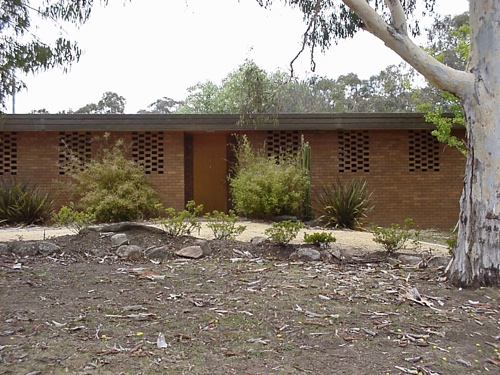4 Cobby Street, Campbell (1969-70)

The Otto Frankl house
4 Cobby Street, Campbell is a three bedroom house designed by Roy Grounds, with Theo Bischoff as project architect, in 1969-70 for Sir Otto and Lady Frankel and was completed in 1970-71. Sir Otto Frankel was Australia’s pre-eminent geneticist and head of the CSIRO Plant Industry Division from 1960-71.
He became acquainted with Grounds during the building of the Australian Academy of Science in 1959, when he was on the building committee and Grounds was the design architect. Grounds later designed this house for Frankel’s retirement, where a significant part of his study and writing took place.
4 Cobby Street is the last of a small number of private residences Grounds designed in Canberra. Like his house at 24 Cobby Street, this house is a late example of a combination of two styles: the post-war Melbourne regional style, with its long, unbroken roofline and widely projecting eaves (in this example, at the rear only); and the post-war international style with its cubiform overall shape and large sheets of glass.
Significance
4 Cobby Street is listed on the ACT Chapter of the Australian Institute of Architects (AIA) Register of Significant Twentieth Century Architecture. It is regarded by the AIA as being an example of significant architecture by a prominent Australian architect and a valuable educational resource for students and designers.
The house is an interesting example of a mixture of the post-war international and post-war Melbourne regional styles and exhibits design features peculiar to both those styles of architecture. The house is also important due to its association with Sir Otto Frankel and the design of this house by Grounds as his retirement residence further highlights its significance.
Grounds designed a number of buildings and houses in Canberra. Other houses are the Forrest Townhouses, 42-46 Vasey Crescent and 24 Cobby Street; the buildings are the Australian Academy of Science (1959) and the CSIRO Phytotron Building (1963).
Description
The house is located on a large block with the Mount Ainslie Nature Park native bushland at the rear and to the east. It has a simple rectangular plan which has a slight curve following the front boundary and street. The concave curve of the front of the house and open brick grills which obscure the windows give the house a terse appearance from the street. It seems that the brick grill detail has been incorporated into the design to disguise the small, irregular windows in the street facade. The same feature can be seen on the western end of the Forrest Townhouses, also designed by Grounds.
The recessed entry opens into a small lobby off an open plan living room. A door to the left opens into the laundry and on into the kitchen, both rooms facing south to the street. The living room is partially separated from the dining room by a brown brick fireplace. These rooms open out to the north east terrace through full height sliding aluminium glazed doors and are fully lined with timber veneered plywood sheets on the walls and spaced boards to the ceilings, with no skirting or cornices.
Joinery around the fireplace includes low level shelving and cupboards, a veneered benchtop and two posts, one of which conceals a structural column, while along the wall with the kitchen there is a servery and more shelving. All joinery matches the panelled walls and both these elements are important to the integrity of the building as a whole.
The bedrooms, wet areas and study extend to the south east off a curved central passage, with each internal wall set out on the radius of the curve. The large (about 25sq m) study is located at the end of the passage with an external door to the south east providing access to the garden via a suspended concrete stair. Two of the bedrooms face northeast while the third and smallest of the bedrooms faces south to the street.
The house is mostly brick veneer with the wet areas and the north east wall of the dining and living areas in cavity brick while the floor structure is reinforced concrete. The external brickwork is a medium brown colour and the flat, metal deck roof has a 450mm high metal fascia that extends out 450mm past the longer north east and south west walls and 1800mm over the north east living, dining and utility terraces.
Source
- Australian Institute of Architects RSTCA citation No. 124